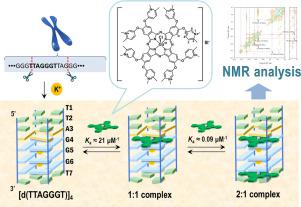Journal of Inorganic Biochemistry ( IF 3.8 ) Pub Date : 2020-10-07 , DOI: 10.1016/j.jinorgbio.2020.111270 Mami Uchiyama 1 , China Okamoto 1 , Atsuya Momotake 1 , Takahisa Ikeue 2 , Yasuhiko Yamamoto 3

|
Interaction between an Ga(III) phthalocyanine (Pc) derivative bearing eight N-methylpyridinium groups at peripheral β-positions (2,3,6,7,10,11,14,15-octakis-[N-methyl-(4-methylpyridinium-3-yloxy)phthalocyaninato] chloro gallium(III) iodide (GaPc)) and an all parallel-stranded tetrameric G-quadruplex formed from a heptanucleotide d(TTAGGGT) ([d(TTAGGGT)]4) has been investigated to elucidate the molecular recognition of G-quadruplex DNA by the Pc derivative, which provides a useful insight as to the design of G-quadruplex ligands suitable for various in vitro and in vivo applications. We found that GaPc binds to the A3G4 and G6T7 steps of [d(TTAGGGT)]4, with binding constants of (21 ± 2) × 106 and (0.09 ± 0.06) × 106 M−1, respectively, to form a 2:1 complex. Obviously, upon the binding of GaPc to each of the sites, the π-π stacking and electrostatic interactions of the Pc moiety and positively-charged side chains of GaPc with a G-quartet and the negatively-charged phosphate groups in nearby phosphodiester bonds of the DNA, respectively, are major driving forces for the complexation. Considering the similarity in the local structural environment between the A3G4 and G6T7 steps of [d(TTAGGGT)]4, the remarkably large difference in the GaPc-binding affinity between them is most likely accounted for by the effect of the polarity of the GaPc-binding site on the intermolecular electrostatic interaction. This finding provides valuable insights as to the design of Pc derivatives as G-quadruplex ligands.
中文翻译:

阳离子酞菁衍生物与所有平行链四聚体G-四链体DNA的逐步结合
在外围β位置带有8个N-甲基吡啶基的Ga(III)酞菁(Pc)衍生物之间的相互作用(2,3,6,7,10,11,14,15-辛基-[ N-甲基-(4-已经研究了甲基吡啶-3-基氧基)酞菁碘化碘化镓(III)和由七核苷酸d(TTAGGGT)([d(TTAGGGT)] 4)形成的所有平行链四聚体G-四链体。Pc衍生物对G-四链体DNA的分子识别,这为设计适用于各种体外和体内应用的G-四链体配体提供了有用的见识。我们发现,GaPc与[d(TTAGGGT)] 4的A3G4和G6T7步骤结合,结合常数为(21±2)×10 6和(0.09±0.06)×10 6 M -1,形成2:1的络合物。显然,在GaPc结合到每个位点后,Pc部分和GaPc的正电荷侧链与G四元组和附近磷酸二酯键中带负电荷的磷酸基团的π-π堆积和静电相互作用。 DNA分别是复合的主要驱动力。考虑到[d(TTAGGGT)] 4的A3G4和G6T7步骤在局部结构环境中的相似性,它们之间GaPc结合亲和力的显着差异很可能是由于GaPc结合位点的极性对分子间静电相互作用的影响所致。该发现为将Pc衍生物设计为G-四链体配体提供了有价值的见解。











































 京公网安备 11010802027423号
京公网安备 11010802027423号